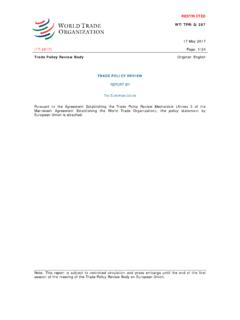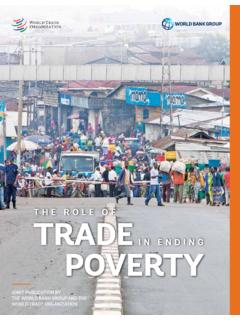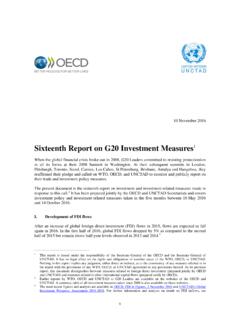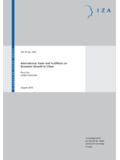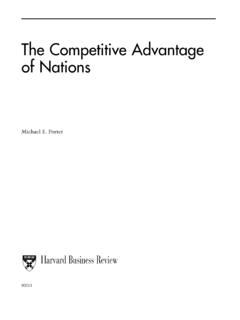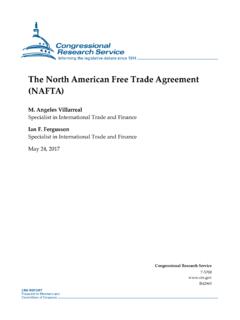Transcription of THE GENERAL AGREEMENT ON TRADE IN SERVICES AN …
1 WTO 31 January 2013 TRADE in SERVICES Division THE GENERAL AGREEMENT ON TRADE IN SERVICES AN INTRODUCTION The GENERAL AGREEMENT on TRADE in SERVICES (GATS) is a relatively new AGREEMENT . It entered into force in January 1995 as a result of the Uruguay Round negotiations to provide for the extension of the multilateral trading system to SERVICES . All Members of the World TRADE Organization are signatories to the GATS and have to assume the resulting obligations. By the same token, they are committed, pursuant to Article XIX of the GATS, to entering into subsequent rounds of TRADE liberalizing negotiations.
2 The first such Round started in January 2000 and was integrated later into the wider context of the Doha Development Agenda (DDA). So, regardless of their countries' policy stances, TRADE officials need to be familiar with this AGREEMENT and its implications for TRADE and development. These implications may be far more significant than available TRADE data suggest. Hopefully, this introduction will contribute to a better understanding of the GATS and the challenges and opportunities associated with commitments under the AGREEMENT . For users who are familiar with the GENERAL AGREEMENT on Tariffs and TRADE (GATT) and the underlying concepts, similarities and differences will be pointed out where relevant.
3 The following text is based on a more comprehensive training module on the GATS which is available on the WTO website ( ). An Annex contains a glossary of the most frequently used terms, for ease of reference. Page 2 1. BASIC PURPOSE AND CONCEPTS Historical Background The GENERAL AGREEMENT on TRADE in SERVICES (GATS) is the first multilateral TRADE AGREEMENT to cover TRADE in SERVICES . Its creation was one of the major achievements of the Uruguay Round of TRADE negotiations, from 1986 to 1993. This was almost half a century after the entry into force of the GENERAL AGREEMENT on Tariffs and TRADE (GATT) of 1947, the GATS' counterpart in merchandise TRADE .
4 The need for a TRADE AGREEMENT in SERVICES has long been questioned. Large segments of the SERVICES economy, from hotels and restaurants to personal SERVICES , have traditionally been considered as domestic activities that do not lend themselves to the application of TRADE policy concepts and instruments. Other sectors, from rail transport to telecommunications, have been viewed as classical domains of government ownership and control, given their infrastructural importance and the perceived existence, in some cases, of natural monopoly situations. A third important group of sectors, including health, education and basic insurance SERVICES , are considered in many countries as governmental responsibilities, reflecting their importance for social integration and regional cohesion, which should be tightly regulated and not be left to the rough and tumble of markets.
5 Nevertheless, some SERVICES sectors, in particular international finance and maritime transport, have been largely open for centuries - as the natural complements to merchandise TRADE . Other large sectors have undergone fundamental technical and regulatory changes in recent decades, opening them to private commercial participation and reducing, even eliminating, existing barriers to entry. The emergence of the Internet has helped to create a range of internationally tradable product variants - from e-banking to tele-health and distance learning - that were unknown only two decades ago, and has removed distance-related barriers to TRADE that had disadvantaged suppliers and users in remote locations (relevant areas include professional SERVICES such as software development, consultancy and advisory SERVICES , etc.)
6 A growing number of governments has gradually exposed previous monopoly domains to competition; telecommunication is a case in point. This reflects a basic change in attitudes. The traditional (monopoly) framework of public service increasingly proved inappropriate for operating some of the most dynamic and innovative segments of the economy, and governments apparently lacked the entrepreneurial spirit and financial resources to exploit fully existing growth potential. SERVICES have recently become the most dynamic segment of international TRADE . Since 1980, world SERVICES TRADE has grown faster, albeit from a relatively modest basis, than merchandise flows.
7 Defying wide-spread misconceptions, developing countries have strongly participated in that growth. Whereas their share of world SERVICES exports, on a Balance of Payments (BOP) basis, amounted to about 20% in 1980, it had risen to by 2000 to reach 31% in 2010. And this share would be far higher, in the order of 50%, if world TRADE was measured in net terms, disregarding imported content and considering only the value added (and traded) by individual economies. Given the continued momentum of world SERVICES TRADE , as a result, not least, of the proliferation of international supply chains, the need for internationally recognized rules became increasingly evident.
8 Basic Purpose As stated in its Preamble, the GATS is intended to contribute to TRADE expansion "under conditions of transparency and progressive liberalization and as a means of promoting the economic growth of all trading partners and the development of developing countries". TRADE expansion is thus not seen as an end in itself, as some critical voices allege, but as an instrument to promote growth and development. Page 3 The link with development is further reinforced by explicit references in the Preamble to the objective of increasing participation of developing countries in SERVICES TRADE and to the special economic situation and the development, TRADE and financial needs of the least-developed countries.
9 The GATS' contribution to world SERVICES TRADE rests on three main pillars: (a) ensuring increased transparency and predictability of relevant rules and regulations, (b) providing a common framework of disciplines governing international transactions, and (c) promoting progressive liberalization through successive rounds of negotiations. Within the framework of the AGREEMENT , the latter concept is tantamount to improving market access and extending national treatment to foreign SERVICES and service suppliers across an increasing range of sectors. It does not, however, entail deregulation. Rather, the AGREEMENT explicitly recognizes governments' right to regulate, and introduce new regulations, to meet national policy objectives and the particular need of developing countries to exercise this right.
10 Definition of SERVICES TRADE and Modes of Supply The definition of SERVICES TRADE under the GATS is four-pronged, depending on the territorial presence of the supplier and the consumer at the time of the transaction. Pursuant to Article I:2, the GATS covers SERVICES supplied (a) from the territory of one Member into the territory of any other Member (Mode 1 - Cross-border TRADE ); (b) in the territory of one Member to the service consumer of any other Member (Mode 2 Consumption abroad); (c) by a service supplier of one Member, through commercial presence, in the territory of any other Member (Mode 3 - Commercial presence); and (d) by a service supplier of one Member, through the presence of natural persons of a Member in the territory of any other Member (Mode 4 - Presence of natural persons).




